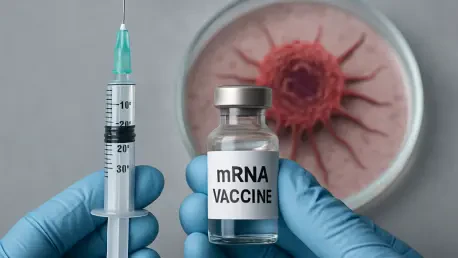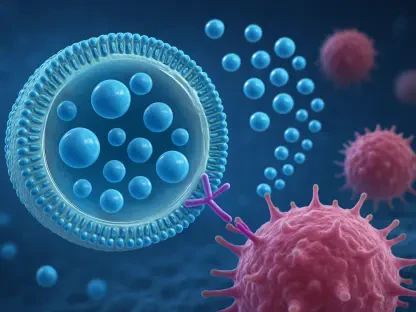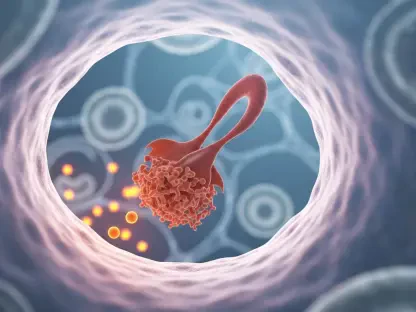Consider a scenario where a patient diagnosed with an aggressive cancer like melanoma faces limited options due to a tumor that resists standard treatments, a reality for many battling “immunologically cold” tumors that evade immune system attacks and fail to respond to powerful therapies like immune checkpoint inhibitors (ICIs). A groundbreaking study published in a leading scientific journal has revealed an unexpected ally in this fight: SARS-CoV-2 mRNA vaccines, originally designed to combat COVID-19, may hold the key to transforming these resistant tumors into targets for immune attack, offering renewed hope for better outcomes.
This guide aims to help readers understand how these vaccines, widely recognized for their role in pandemic response, could revolutionize cancer care by enhancing ICI therapies. It explores the potential for patients with challenging cancers such as non-small cell lung cancer (NSCLC) and melanoma to benefit from a synergy between mRNA vaccines and existing immunotherapies. By delving into clinical evidence, mechanisms, and practical implications, this resource seeks to inform patients, caregivers, and healthcare professionals about an emerging approach that could reshape treatment landscapes.
The importance of this development cannot be overstated, as many cancer patients struggle with limited responses to current therapies. Cold tumors pose a significant barrier, often leaving individuals with few viable options. By presenting a detailed roadmap of how mRNA vaccines might sensitize these tumors to treatment, this guide offers a glimpse into a potential paradigm shift in oncology, highlighting a practical and accessible strategy that leverages tools already at hand.
Understanding the Journey of mRNA Technology in Medicine
The path of mRNA vaccine technology began with a focus on infectious diseases, most notably through the rapid development of vaccines against COVID-19 by pharmaceutical giants like Pfizer and Moderna. These vaccines work by instructing cells to produce a viral protein, triggering a robust immune response without causing illness. Their success in preventing severe disease during the global health crisis marked a historic milestone, demonstrating the power of mRNA platforms to address urgent public health needs with speed and efficacy.
Recognizing the immune-activating potential of these vaccines, researchers turned their attention to oncology, where boosting immune responses is often critical to overcoming tumor resistance. The challenge of immunologically cold tumors, which lack sufficient immune cell presence to respond to ICIs, prompted exploration into whether mRNA vaccines could stimulate the necessary immune activity. This shift represents a significant pivot, as scientists began to see these vaccines not just as preventive tools but as potential adjuvants in cancer therapy.
This repurposing of an existing medical technology underscores a broader trend of innovation in healthcare, where solutions developed for one purpose find new applications in unrelated fields. The accessibility and scalability of mRNA vaccines, already produced at a massive scale, make them a compelling candidate for integration into cancer treatment protocols. This guide will build on this foundation, detailing how such a transition from pandemic response to oncology could offer practical benefits for patients facing significant therapeutic hurdles.
Step-by-Step Guide to Enhancing Cancer Treatment with mRNA Vaccines
This section provides a structured approach to understanding how SARS-CoV-2 mRNA vaccines can be utilized to improve outcomes in ICI therapy for cancers like NSCLC and melanoma. Each step is supported by clinical data, mechanistic insights, and practical considerations to ensure clarity.
Step 1: Recognize the Role of mRNA Vaccines in Sensitizing Tumors
Begin by understanding that mRNA vaccines, designed to fight COVID-19, can play a transformative role in cancer care by “heating up” immunologically cold tumors. These tumors typically resist ICI therapies due to a lack of immune cell infiltration, but the vaccines stimulate a systemic immune response that alters the tumor microenvironment. Research indicates that this process makes tumors more recognizable to the immune system, paving the way for effective ICI intervention.
To apply this knowledge, patients and healthcare providers should consider the timing of vaccination relative to ICI treatment initiation. Evidence suggests that receiving an mRNA vaccine within a close window—specifically within 100 days of starting ICI therapy—may maximize the immune-boosting effect. This step is foundational, as it sets the stage for leveraging an accessible tool to address a critical gap in cancer treatment efficacy.
Step 2: Explore Clinical Evidence of Improved Survival Rates
Dive into the clinical data demonstrating survival benefits for patients with NSCLC and melanoma who received mRNA vaccines alongside ICI therapy. A retrospective analysis from a major cancer center revealed that vaccinated NSCLC patients achieved a 3-year overall survival rate of 55.7%, compared to just 30.8% for unvaccinated counterparts. Similarly, melanoma patients showed a 3-year survival rate of 67.6% versus 44.1% in the unvaccinated group, marking a substantial reduction in mortality risk.
It’s noteworthy that this survival advantage was unique to mRNA-based vaccines and not observed with other types, such as influenza or pneumococcal vaccines. This specificity highlights the distinct immune activation triggered by mRNA technology, offering a compelling reason to prioritize its use in specific cancer treatment contexts. Patients and clinicians should review such data to assess eligibility and potential benefits for individual cases.
Step 3: Understand the Mechanism Behind Immune Activation
Grasp the biological mechanisms driving the synergy between mRNA vaccines and ICI therapy, particularly the role of a type-I interferon (IFN) surge. Preclinical studies using murine models of cold tumors showed that a laboratory version of an mRNA vaccine, when combined with an anti-PD-1 ICI, enhanced anti-tumor responses by triggering a massive IFN-α increase. This surge mimics a viral infection, activating innate immunity and promoting T-cell infiltration into tumors.
Further insights reveal that the IFN surge leads to epitope spreading, where T-cells begin to target a broader range of tumor antigens, amplifying the immune attack. Additionally, tumors respond by upregulating PD-L1 as a defense mechanism, which ICIs can counteract to sustain anti-tumor activity. Understanding this interplay is crucial for appreciating how a vaccine designed for a virus can indirectly bolster cancer-fighting capabilities.
Step 4: Consider Immune Response Dynamics and Dosage Effects
Examine the immune activation observed in healthy volunteers receiving mRNA vaccines, where blood analyses showed a dramatic 280-fold increase in IFN-α levels within 24 hours post-vaccination. This response varied slightly based on dosage, with higher mRNA content in some vaccines eliciting stronger interferon signals. Such findings underscore the potency of these vaccines as immune modulators, even when targeting non-cancer antigens like the SARS-CoV-2 spike protein.
Timing and dosage considerations remain areas of active investigation, as optimal scheduling of vaccination relative to ICI therapy is not yet fully defined. Healthcare providers should monitor emerging research to refine protocols, ensuring that patients receive vaccinations at a point that maximizes immune synergy. Staying informed about dose-dependent effects can also guide decisions on which vaccine formulation might be most effective in a therapeutic context.
Step 5: Evaluate Practical Advantages of Off-the-Shelf Vaccines
Assess the practicality of using off-the-shelf mRNA vaccines compared to personalized cancer vaccines, which are costly and time-intensive to produce. SARS-CoV-2 mRNA vaccines are widely available and relatively inexpensive, making them a scalable option for enhancing ICI responses across diverse patient populations. This accessibility addresses a major barrier in oncology, where equitable access to cutting-edge treatments often remains elusive.
To implement this step, healthcare systems and providers can prioritize integrating these vaccines into treatment plans for eligible patients, focusing on those with cold tumors resistant to standard therapies. Collaboration between oncologists and immunization specialists may be necessary to streamline logistics, ensuring that vaccination aligns with therapeutic goals. This approach offers a cost-effective pathway to potentially life-saving outcomes.
Step 6: Acknowledge Limitations and Advocate for Further Research
Recognize that while the findings are promising, they stem from observational data and require validation through prospective clinical trials. Current evidence, though compelling, carries limitations such as potential patient selection biases and the retrospective nature of the analyses. These uncertainties necessitate caution in broadly applying this approach without additional confirmation.
Patients and clinicians should advocate for and participate in upcoming trials to help establish causality and optimize treatment protocols, including timing and dosage. Staying engaged with research updates ensures that any advancements in this field are quickly translated into clinical practice. This step emphasizes the importance of a scientific mindset, balancing optimism with rigorous evaluation.
Key Insights into mRNA Vaccines as a Cancer Treatment Booster
Summarize the critical takeaways from this emerging field in a clear, concise format to reinforce understanding:
- SARS-CoV-2 mRNA vaccines can transform immunologically cold tumors into responsive targets for ICI therapy.
- A type-I interferon surge is central to immune activation, driving T-cell infiltration and epitope spreading.
- Clinical evidence shows notable survival improvements for NSCLC and melanoma patients vaccinated near ICI treatment start.
- Off-the-shelf mRNA vaccines provide a practical, scalable alternative to bespoke cancer vaccines.
- Ongoing prospective trials are essential to confirm these observational findings and refine application strategies.
Looking Ahead at Cancer Immunotherapy Innovations
The integration of mRNA vaccines into cancer care aligns with broader trends in oncology, where overcoming tumor resistance remains a top priority. This approach reflects a growing emphasis on immune modulation as a cornerstone of effective treatment, particularly for cancers that evade conventional therapies. As research progresses, the potential to apply these findings beyond NSCLC and melanoma to other cancer types offers a tantalizing prospect for expanding therapeutic reach.
Challenges persist in generalizing these results, as different cancers may respond variably to immune activation strategies. Prospective clinical trials, expected to unfold over the coming years, will play a pivotal role in clarifying which patient groups stand to benefit most. Additionally, optimizing vaccine timing and dosage remains a critical area for investigation, ensuring that protocols are tailored for maximum impact.
The momentum behind mRNA technology in oncology also raises questions about accessibility and implementation on a global scale. Addressing disparities in healthcare delivery will be essential to ensure that such innovations do not remain confined to well-resourced settings. Future developments may focus on streamlining integration into routine care, potentially transforming how resistant cancers are managed across diverse populations.
Reflecting on a Transformative Approach in Cancer Care
Looking back, the exploration of SARS-CoV-2 mRNA vaccines as enhancers of ICI therapy marked a significant turning point in the fight against resistant tumors. Each step—from recognizing their immune-boosting potential to advocating for rigorous clinical validation—laid the groundwork for a novel strategy that addressed longstanding challenges in oncology. The journey illuminated a path toward improved survival for patients with aggressive cancers.
Moving forward, the focus shifted to actionable next steps, such as supporting and participating in clinical trials to refine this approach. Healthcare providers and patients alike began prioritizing awareness of emerging data on optimal timing and dosage, ensuring that therapeutic benefits were maximized. Engaging with research communities to address scalability and equity in access became a critical consideration.
Ultimately, the potential of mRNA vaccines to democratize effective cancer treatments emerged as a guiding vision. Efforts concentrated on translating these early findings into standardized protocols, paving the way for broader application. This evolving field promised to redefine possibilities, offering renewed optimism for those facing the toughest battles in cancer care.









